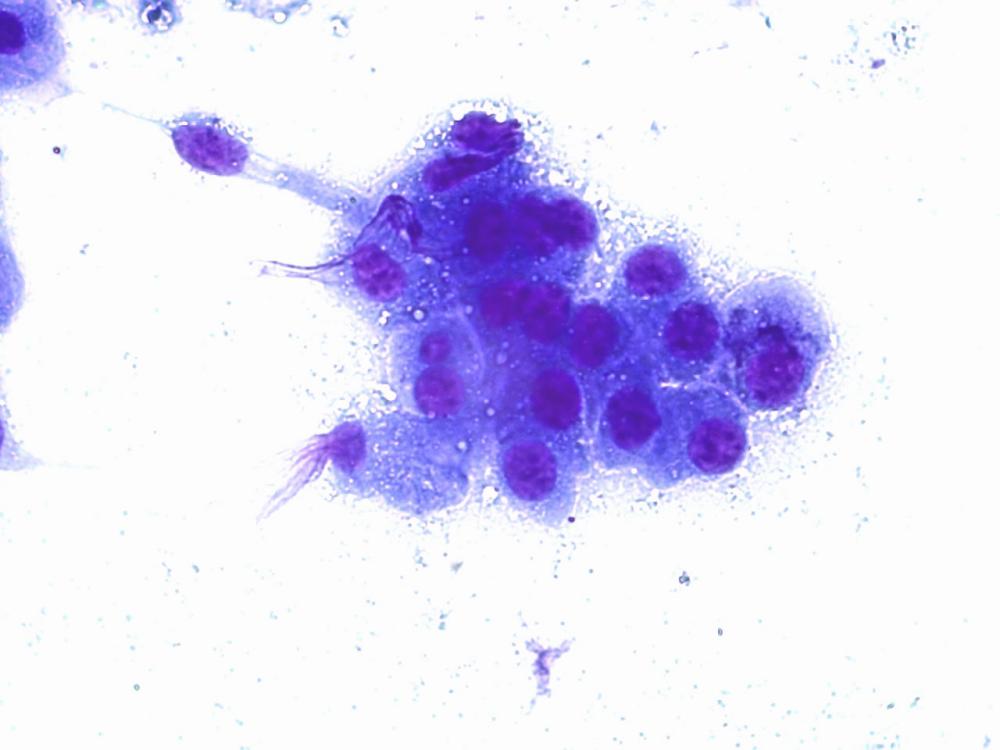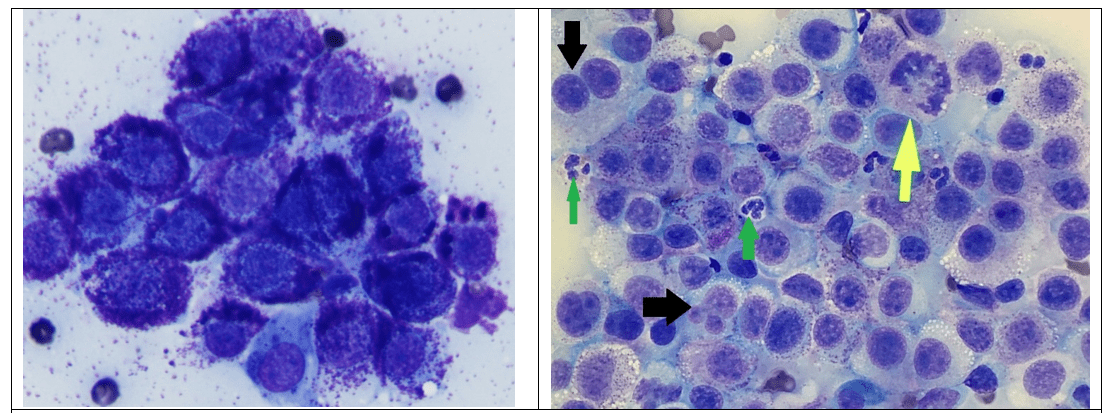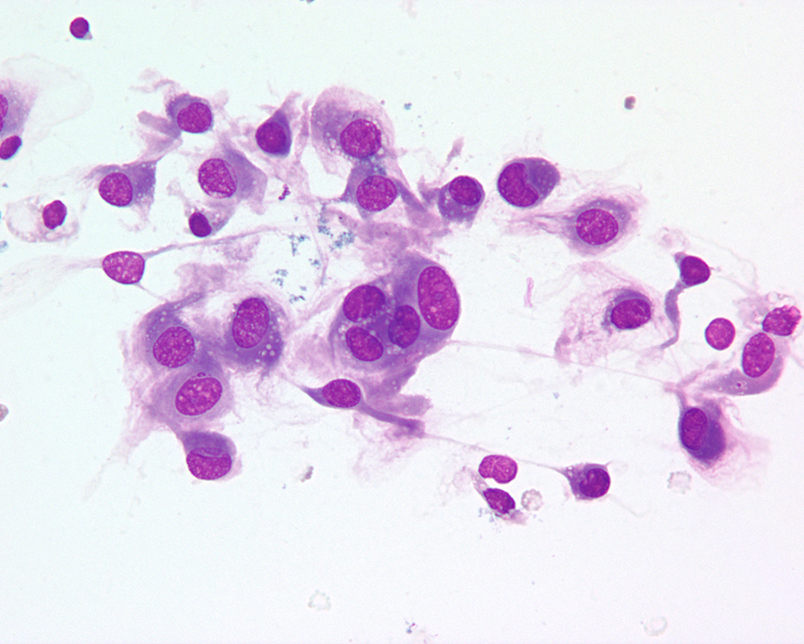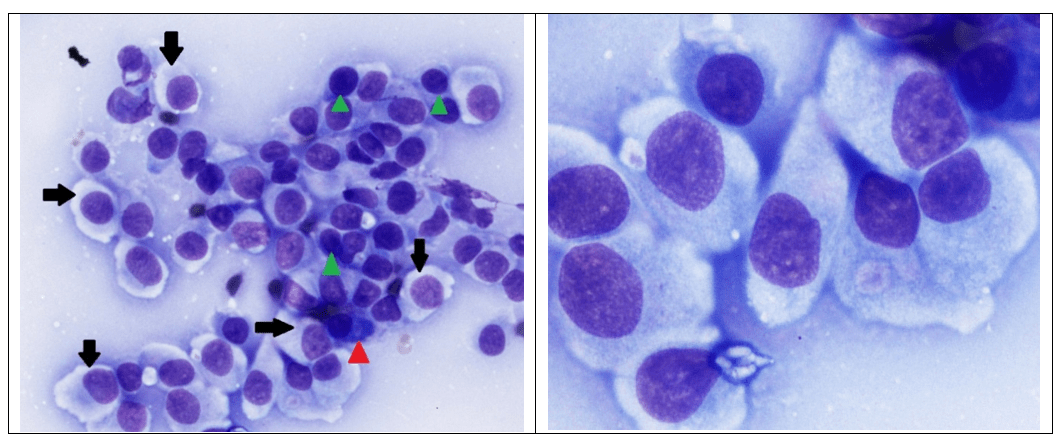Mesenchymal cell tumor dog
Mesenchymal Cell Tumor Dog. They are most often found on the limbs and trunk of the body but can also be found in the nasal cavity or mouth. If the skin tumor is malignant the dog will also display some symptoms such as skin itchiness redness lack of appetite lethargy and flaky skin. Mast cell tumors are the most common round cell tumor in the dog. Tumors are abnormal growths of cells.
 Cytology Of Neoplasia An Essential Component Of Diagnosis Today S Veterinary Practice From todaysveterinarypractice.com
Cytology Of Neoplasia An Essential Component Of Diagnosis Today S Veterinary Practice From todaysveterinarypractice.com
All tumors occurred as solitary soft to firm solid tan and ulcerated masses in the digits ofdogs aged II to 15 years. Indeed epithelial tumors undergo epithelial-to-mesenchymal transition when they are metastasizing so spindled cells within an epithelial tumor may represent the tumor undergoing EMT or reactive fibroplasia eg. Cancerous cells typically do not resemble the cells of surrounding areas and tumors generally contain cells that vary in size and appearance. They are most often found on the limbs and trunk of the body but can also be found in the nasal cavity or mouth. The nuclei are often oval but occasionally round. As carcinomas become less differentiated they lose some of these features and often become less cohesive mimicking mesenchymal cells.
As carcinomas become less differentiated they lose some of these features and often become less cohesive mimicking mesenchymal cells.
Inflammation is also strongly related to cTCC. Cancerous cells typically do not resemble the cells of surrounding areas and tumors generally contain cells that vary in size and appearance. Epithelial tumors and sex cord stromal tumors together account for 80-90 of all canine ovarian tumors. About a third of all tumors that occur in canines are mesenchymal. Four examples ofa mesenchymal tumor of undetermined histogenesis occurred in three mixed breed dogs and one Yorkshire terrier. Mesenchymal tissue is made up of loosely associated cells which means this type of tissue can migrate easily.
 Source: todaysveterinarypractice.com
Source: todaysveterinarypractice.com
Epithelial tumors and sex cord stromal tumors together account for 80-90 of all canine ovarian tumors. Mast cell tumors account for approximately 20 percent of all canine skin tumors. Tumors are abnormal growths of cells. Epithelial tumors and sex cord stromal tumors together account for 80-90 of all canine ovarian tumors. Canine tumor necrosis factor-α.
 Source: researchgate.net
Source: researchgate.net
Older dogs and certain breeds. About a third of all tumors that occur in canines are mesenchymal. Tumors are abnormal growths of cells. Round cell tumors which can be of several types including lymphosarcoma mast cell tumors histiocytomas plasma cell tumors. Canine mesenchymal stromal cells.
 Source: msdvetmanual.com
Source: msdvetmanual.com
It is highly invasive and exhibits metastatic characteristics. They can occur in any breed age or gender but mast cell tumors tend to occur in older dogs and are more common in breeds descended from the bulldog eg Boxers. Mesenchymal tumors appear on the skin and are the most common type of tumors in dogs. These obstacles can be overcome by the use of a delivery vehicle transformed with effective vectors to target the tumor region. Most mast cell tumors can be treated with surgical removal without a recurrence.
 Source: todaysveterinarypractice.com
Source: todaysveterinarypractice.com
FICC used in the present study demonstrated that this method could non-invasively evaluate EMT in epithelial tumor cells in dogs and cats. Mesenchymal tumors include those tumors arising from the supporting mesenchymal tissues of the dermis and subcutis fibrous connective tissue blood vessels lymphatics nerves adipose tissue and smooth muscle and those round cell tumors of mesenchymal origin that present as cutaneous masses. However if the tumor has metastasized or spread the prognosis isnt good. Mesenchymal Tumors of the Skin and Soft Tissues. Tumors affecting the skin or the tissue just under the skin are the most commonly seen tumors in dogs.
 Source: mspca.org
Source: mspca.org
These tumors may be located in all organs with a higher. FICC used in the present study demonstrated that this method could non-invasively evaluate EMT in epithelial tumor cells in dogs and cats. Mast cell tumors start in the skin but if they grow aggressively they. Four examples ofa mesenchymal tumor of undetermined histogenesis occurred in three mixed breed dogs and one Yorkshire terrier. Inflammation is also strongly related to cTCC.

Epithelial tumors and sex cord stromal tumors together account for 80-90 of all canine ovarian tumors. They are most often found on the limbs and trunk of the body but can also be found in the nasal cavity or mouth. Its important to note that very aggressive tumors considered Grade 3 are also the. Hemangiosarcoma is a malignant mesenchymal tumor arising from vascular endothelial cells that can develop in any tissue but the most frequent primary locations in dogs are the spleen 2863 right atrium and auricle 350. Mesenchymal Tumors of the Skin and Soft Tissues.
 Source: cancerres.aacrjournals.org
Source: cancerres.aacrjournals.org
Epithelial tumors and sex cord stromal tumors together account for 80-90 of all canine ovarian tumors. Tumors affecting the skin or the tissue just under the skin are the most commonly seen tumors in dogs. If the skin tumor is malignant the dog will also display some symptoms such as skin itchiness redness lack of appetite lethargy and flaky skin. These tumors may be located in all organs with a higher. Mesenchymal tissue neoplasms are soft tissue tumors also known as connective tissue tumors which are relatively frequent in domestic animals and have a high incidence in some species.
 Source: vetmed.illinois.edu
Source: vetmed.illinois.edu
They are epithelial tumors germ cell tumors and sex cord stromal cell tumors. Indeed epithelial tumors undergo epithelial-to-mesenchymal transition when they are metastasizing so spindled cells within an epithelial tumor may represent the tumor undergoing EMT or reactive fibroplasia eg. About a third of all tumors that occur in canines are mesenchymal. However in dogs FICC could not detect the EMT phenomenon in three cases tubulopapillary carcinoma of the mammary gland follicular adenoma of the thyroid gland and adenosquamous carcinoma of the lung. Inflammation is also strongly related to cTCC.
 Source: vetsmall.theclinics.com
Source: vetsmall.theclinics.com
Its important to note that very aggressive tumors considered Grade 3 are also the. Canine mesenchymal stromal cells. However oftentimes tumors that may have the potential to become malignant are passed over as benign lesions. They usually originate from the connective tissue of the skin and beneath the skin but occasionally from the bone causing a primary form of bone cancer. Mast cell tumors are one of the most rewarding round cell tumors to diagnose because they are readily identified by the presence of their distinctive purple mast cell tumors.
 Source: researchgate.net
Source: researchgate.net
Multiple dog breeds are predisposed to developing mast cell tumors which may be solitary or multicentric. Most mast cell tumors can be treated with surgical removal without a recurrence. Mesenchymal tissue neoplasms are soft tissue tumors also known as connective tissue tumors which are relatively frequent in domestic animals and have a high incidence in some species. Skin tumors are diagnosed more frequently than other tumors in animals in part because they are the most easily seen tumors and in part because the skin is constantly exposed to many tumor-causing factors in the environment. Mesenchymal tumors include those tumors arising from the supporting mesenchymal tissues of the dermis and subcutis fibrous connective tissue blood vessels lymphatics nerves adipose tissue and smooth muscle and those round cell tumors of mesenchymal origin that present as cutaneous masses.
 Source: veteriankey.com
Source: veteriankey.com
Fibrosarcoma cat Fibrosarcoma cat Keloidal fibromafibrosarcoma DQ Keloidal fibromafibrosarcoma DQ Keloidal fibromafibrosarcoma DQ Keloidal fibromafibrosarcoma PB Giant cell tumor of soft parts horse. Most pose no threat to the dog. They account for 20-25 of all skin tumors in dogs. It is highly invasive and exhibits metastatic characteristics. Canine transitional cell carcinoma cTCC is the most common malignant tumour in the urinary bladder.
 Source: mspca.org
Source: mspca.org
The life expectancy of a dog with a mast cell tumor depends on the stage and grade of the tumor the location treatment options chosen the particular strain of mast cell tumor and the overall health of the dog. About a third of all tumors that occur in canines are mesenchymal. Mesenchymal tumors appear on the skin and are the most common type of tumors in dogs. Most tumors occur in middle-aged and older dogs. They can occur in any breed age or gender but mast cell tumors tend to occur in older dogs and are more common in breeds descended from the bulldog eg Boxers.
If you find this site beneficial, please support us by sharing this posts to your favorite social media accounts like Facebook, Instagram and so on or you can also save this blog page with the title mesenchymal cell tumor dog by using Ctrl + D for devices a laptop with a Windows operating system or Command + D for laptops with an Apple operating system. If you use a smartphone, you can also use the drawer menu of the browser you are using. Whether it’s a Windows, Mac, iOS or Android operating system, you will still be able to bookmark this website.







